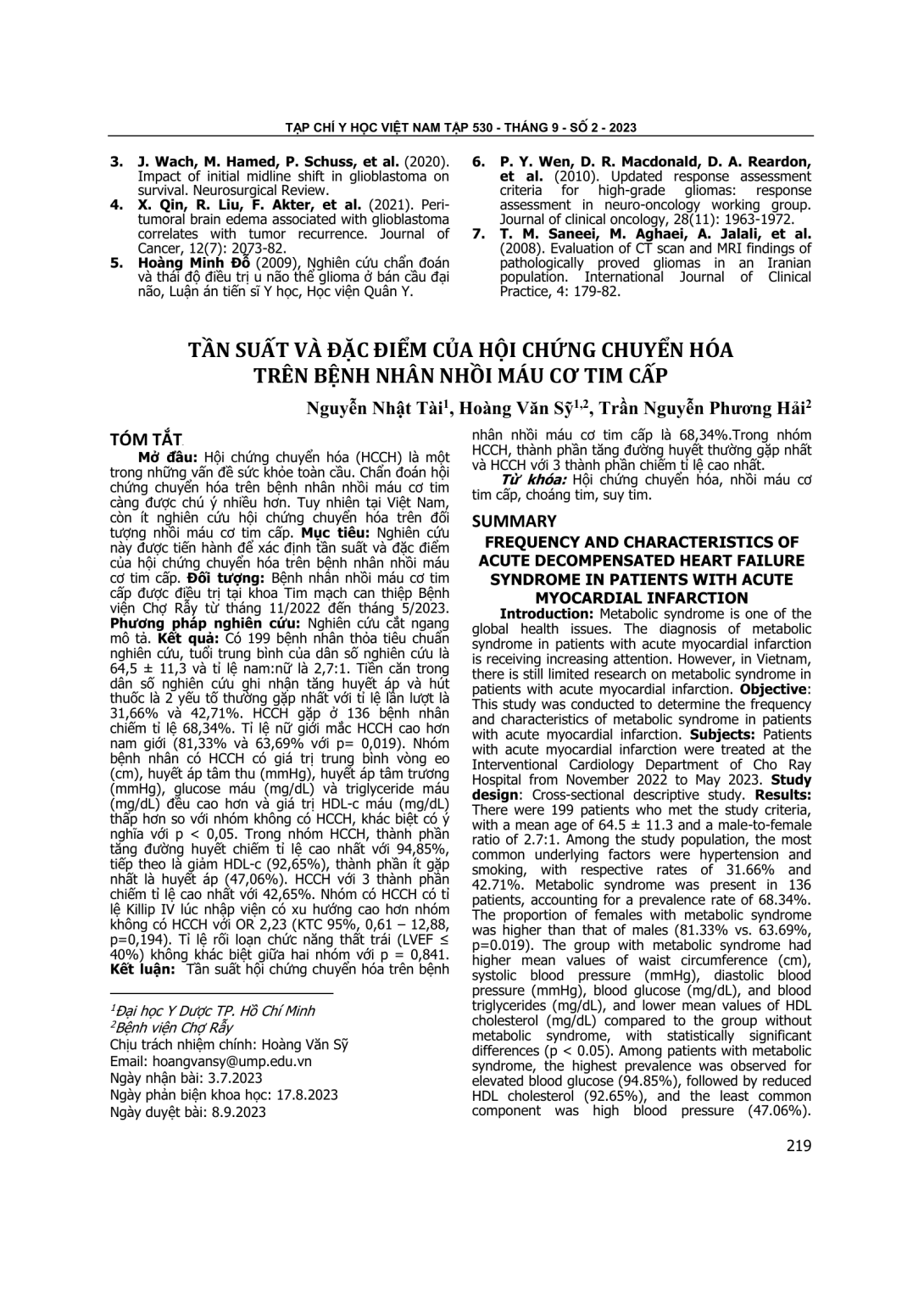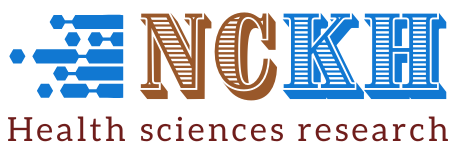
Hội chứng chuyển hóa (HCCH) là một trong những vấn đề sức khỏe toàn cầu. Chẩn đoán hội chứng chuyển hóa trên bệnh nhân nhồi máu cơ tim càng được chú ý nhiều hơn. Tuy nhiên tại Việt Nam, còn ít nghiên cứu hội chứng chuyển hóa trên đối tượng nhồi máu cơ tim cấp. Mục tiêu: Nghiên cứu này được tiến hành để xác định tần suất và đặc điểm của hội chứng chuyển hóa trên bệnh nhân nhồi máu cơ tim cấp. Đối tượng: Bệnh nhân nhồi máu cơ tim cấp được điều trị tại khoa Tim mạch can thiệp Bệnh viện Chợ Rẫy từ tháng 11/2022 đến tháng 5/2023. Phương pháp nghiên cứu: Nghiên cứu cắt ngang mô tả. Kết quả: Có 199 bệnh nhân thỏa tiêu chuẩn nghiên cứu, tuổi trung bình của dân số nghiên cứu là 64,5 ± 11,3 và tỉ lệ nam:nữ là 2,7:1. Tiền căn trong dân số nghiên cứu ghi nhận tăng huyết áp và hút thuốc là 2 yếu tố thường gặp nhất với tỉ lệ lần lượt là 31,66% và 42,71%. HCCH gặp ở 136 bệnh nhân chiếm tỉ lệ 68,34%. Tỉ lệ nữ giới mắc HCCH cao hơn nam giới (81,33% và 63,69% với p= 0,019). Nhóm bệnh nhân có HCCH có giá trị trung bình vòng eo (cm), huyết áp tâm thu (mmHg), huyết áp tâm trương (mmHg), glucose máu (mg/dL) và triglyceride máu (mg/dL) đều cao hơn và giá trị HDL-c máu (mg/dL) thấp hơn so với nhóm không có HCCH, khác biệt có ý nghĩa với p < 0,05. Trong nhóm HCCH, thành phần tăng đường huyết chiếm tỉ lệ cao nhất với 94,85%, tiếp theo là giảm HDL-c (92,65%), thành phần ít gặp nhất là huyết áp (47,06%). HCCH với 3 thành phần chiếm tỉ lệ cao nhất với 42,65%. Nhóm có HCCH có tỉ lệ Killip IV lúc nhập viện có xu hướng cao hơn nhóm không có HCCH với OR 2,23 (KTC 95%, 0,61 – 12,88, p=0,194). Tỉ lệ rối loạn chức năng thất trái (LVEF ≤ 40%) không khác biệt giữa hai nhóm với p = 0,841. Tần suất hội chứng chuyển hóa trên bệnh nhân nhồi máu cơ tim cấp là 68,34%.Trong nhóm HCCH, thành phần tăng đường huyết thường gặp nhất và HCCH với 3 thành phần chiếm tỉ lệ cao nhất.
Metabolic syndrome is one of the global health issues. The diagnosis of metabolic syndrome in patients with acute myocardial infarction is receiving increasing attention. However, in Vietnam, there is still limited research on metabolic syndrome in patients with acute myocardial infarction. Objective: This study was conducted to determine the frequency and characteristics of metabolic syndrome in patients with acute myocardial infarction. Subjects: Patients with acute myocardial infarction were treated at the Interventional Cardiology Department of Cho Ray Hospital from November 2022 to May 2023. Study design: Cross-sectional descriptive study. Results: There were 199 patients who met the study criteria, with a mean age of 64.5 ± 11.3 and a male-to-female ratio of 2.7:1. Among the study population, the most common underlying factors were hypertension and smoking, with respective rates of 31.66% and 42.71%. Metabolic syndrome was present in 136 patients, accounting for a prevalence rate of 68.34%. The proportion of females with metabolic syndrome was higher than that of males (81.33% vs. 63.69%, p=0.019). The group with metabolic syndrome had higher mean values of waist circumference (cm), systolic blood pressure (mmHg), diastolic blood pressure (mmHg), blood glucose (mg/dL), and blood triglycerides (mg/dL), and lower mean values of HDL cholesterol (mg/dL) compared to the group without metabolic syndrome, with statistically significant differences (p < 0.05). Among patients with metabolic syndrome, the highest prevalence was observed for elevated blood glucose (94.85%), followed by reduced HDL cholesterol (92.65%), and the least common component was high blood pressure (47.06%). Metabolic syndrome with three components accounted for the highest proportion at 42.65%. The presence of metabolic syndrome tended to be associated with a higher proportion of Killip IV classification at admission compared to the group without metabolic syndrome, with an odds ratio of 2.23 (95% CI: 0.61-12.88, p=0.194). The prevalence of left ventricular dysfunction (LVEF ≤ 40%) did not differ between the two groups, with p = 0.841. Conclusion: The frequency of metabolic syndrome in patients with acute myocardial infarction is 68.34%. Among the group with metabolic syndrome, elevated blood glucose is the most common component, and metabolic syndrome with three components has the highest prevalence.
- Đăng nhập để gửi ý kiến
